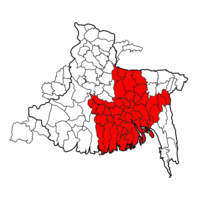Bangali (ethnic dialect)
Bangali is an dialect cluster of the Bengali language spoken in parts of Bangladesh. Sukumar Sen classified this dialect from other dialects.[2] The group includes most languages of the eastern subgroup of Bengali-Assamese languages, excluding Assamese, Rohingya, Chakma and Tanchangya since their speakers aren't considered as Bengali people. The dialect or group generally also excludes the Sylheti and Chittagonian dialects (considered Independent languages by some). The Bangali dialect is spoken across the Divisions of Mymensingh, Dhaka, Comilla, Barisal and Khulna (excluding Satkhira district) in Bangladesh and the Indian state of Tripura. The Bangali speaking region covers most of the land of Bengal region.
| Bangali | |
|---|---|
| Bāṅgālī | |
| বাঙ্গালী | |
 | |
| Native to | Bangladesh |
| Region | Khulna, Dhaka, Mymensingh, Comilla Tripura |
Indo-European
| |
| Bengali alphabet | |
| Language codes | |
| ISO 639-3 | – |
| Glottolog | east2744 Eastern Bengali[1] |
Features
- Most of [e] sounds of Standard Bengali are [ɛ].
- [o] sounds are [ʊ].
- gulo, gula, gulain use as plural number instead of guli in some subdialects.
- Aspirations are lite or is not used.
- Standard Bengali /tʃ/ and /tʃʰ/ are /s/ and /tsʰ/ or /ts/.
- Most subdialects have tones.
- Standard Bengali /ʃ/ is /ɦ/ or absent especially in non-final positions in many subdialects.
- Standard Bengali /p/ and /pʰ/ are /ɸ/ in some subdialects and /ɦ/ in Nokhailla subdialect.
- Many subdialects have [m] and [n] which are nasal on vowels in Standard Bengali.
Examples:
1. (in IPA)
- English: The thieves are being beaten.
- Standard Bengali: /tʃorgulo maːr kʰatʃtʃʰe/
- A Bangali subdialect: /tsʊɾgulain piɖani kʰaitase/
2.
- English: A man had two sons.
- Standard Bengali: æk jon loker duţi chhele chhilo.
- Manikganji subdialect: zoner duiđi saoal asilo.}}
- Mymensinghiya subdialect: æk zôner dui put asilo.
- Munshiganji subdialect (Bikrampur): æk jôner duiđa pola asilo. (P)
- Comillan subdialect: æk bæđar/zôner dui put asilo. (P)
- Noakhali subdialect (Sandwip): egga mainsher duga hut/hula asilo.
- Nokhailla subdiaoect (Feni): egga mainsher duga hut/hula asilo. (P)
- Nokhailla subdialect (Hatia): egga mainsher duga hut/hula asilo. (P)
- Noakhailla subdialect (Ramganj): egga mainsher duga hut/hula asilo.
- Sylheti language: ex beţar dugu fua/fut/sabal asil/aslo.
- Chittagonian language: ugga mainshôr dugga fua asil.
- Chuadanga subdialect: æk jon lokir duiţo seile silo.
- Khulnaiya subdialect: æk zon manshir dui soal silo.
- Jessore subdialect: æk zoner duđe soal sêlo. (P)
- Borishailla subdialect (Bakerganj): æk zôn mansher/manur dugga pola asil.
- Foridpuri subdialect: kero mansher dugga pola silo.
- Satkhira subdialect: æk loker duđi sabal selo.
- Kushtia subdialect: æk mansher duđi seile silo.
gollark: Or you can ask ubq to install the compiler and make your entry shell out to it.
gollark: That's not in the list, but if it compiles to C and you can fit the output in under 20KB, yes.
gollark: Or ask ubq for it as a dependency.
gollark: No, I mean bundle/download an interpreter for it with your entry.
gollark: The osmarkslisp™ one is available for public use, so you could use that.
See also
References
- Hammarström, Harald; Forkel, Robert; Haspelmath, Martin, eds. (2017). "Eastern Bengali". Glottolog 3.0. Jena, Germany: Max Planck Institute for the Science of Human History.
- বাংলা ভাষা ও উপভাষা, সুকুমার সেন, আনন্দ পাবলিশার্স
This article is issued from Wikipedia. The text is licensed under Creative Commons - Attribution - Sharealike. Additional terms may apply for the media files.